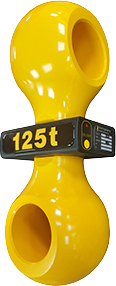TEXT ABOVE
Welcome to the world of colossal strength housed in a sleek, compact design—the Ron 200-ton dynamometer. From aerospace to automotive, this formidable tool holds the key to precision and power when weighing during lifting.
But just what is a 200-ton dynamometer? First off, there are many types of dynamometers: hydraulic dynamometers, eddy current dynamometers, Prony brake dynamometers, and others. But the 200-ton Ron dynamometer is a tension dynamometer, used to measure force, tension, or weight in lifted loads or other tension applications. The “200” means this dynamometer has a maximum capacity of up to 200 tons—strong enough to lift a Boeing Dreamlifter wide-body cargo jet.
Tension dynamometer
Not all dynamometers are created equal. Tension dynamometers, like those manufactured by Eilon Engineering, are precision instruments and often play a crucial role in various industries, such as construction, transportation, and manufacturing. Our tension dynamometers feature a robust design including the weight-bearing load cell with a strain gauge that can precisely detect and quantify the lifted load.
A 200-ton dynamometer is versatile and might be used in construction sites to lift and measure heavy equipment, or in the maritime industry to measure the strain on a ship’s rigging. Tension dynamometers contribute significantly to maintaining operational safety and integrity across a range of applications.
Aerospace dynamometer
Dynamometers, including large 200-ton dynamometers, are frequently used in the aerospace sector in a number of ways, including:
- Weighing fuel tanks, payloads, and other components as part of the assembly process
- Load testing various structures and components of aircraft
- Testing and calibration of loads for launch vehicles and spacecraft
- Precise lifting and transportation of large components and payloads to and from launch sites
- Meticulous balancing of aircraft wings and other components for proper loading and balance
- Accurate measurement of the weight of aircraft parts during assembly and disassembly processes
- Testing and calibration of robotic arms, manipulators, and other mechanical components
- Assessment of the weight of aircraft components during transportation and storage for safety and operational integrity
As you can see, a quality aerospace dynamometer is an integral part of many operations in that sector. So it makes sense that when it comes to performing such high-stakes operations, aerospace companies choose only the very best systems with a reputation for excellence.
With close to five decades in the market, Eilon Engineering stands out among aerospace dynamometer manufacturers and is frequently used by companies such as NASA, Boeing, Northrop Grumman, Lockheed Martin, General Electric, Honeywell, and others.
What to consider when choosing a 200-ton dynamometer
If you need a large-capacity dynamometer for measuring tension or weighing, there are several factors you should consider.
Accuracy
Precision is always important, so you’ll want a system that is highly accurate. Look for a dynamometer with an accuracy of 0.1% of its full range.
Quality
When companies large and small need to weigh heavy, expensive equipment, you can be sure they look for only the highest quality weighing systems. Because when valuable equipment and personnel are on the line, there’s no room to compromise on safety. That’s why having a dynamometer made of aerospace-quality steel is a must.
Durability
No matter what sector or application you have in mind, you’ll need a dynamometer that is durable. At the end of the day, in a high-stakes lifting application, you’ll want the piece of mind that comes from knowing your equipment is built to last.
Portability & headroom loss
A well-constructed 200-ton dynamometer should have a minimalist design—only what’s needed and nothing more. This will give you a system that is both portable and minimizes headroom loss.
The Ron 200-ton dynamometer is remarkably lightweight and compact for its lifting ability, with the load cell body weighing only about 125 pounds or 57kg.
Customization
Since every lifting application is different and has its own unique challenges, you’ll want a dynamometer that offers various customization options to help meet your specific needs.
Ease of use
Any type of dynamometer should be easy to use and operate. This goes beyond mere convenience since an easy-to-use, intuitive system will help prevent operator error. This can be critical when it comes to ensuring onsite safety.
Wireless Dynamometer
One final consideration is whether you need a standard wired system, or a wireless dynamometer. These are also known as telemetry dynamometers and represent the latest in lifting technology.
A wireless dynamometer allows operators to remain at a safe distance from the lifted load, all while effortlessly reading and monitoring measurements via the remote handheld display.
Further, a wireless system saves both time and money during installation, as there are no messy cables or wires to run. And, by eliminating the need for cables, telemetry dynamometers also increase safety by eliminating the potential tripping hazard caused by those cables.
Telemetry dynamometers make use of radio frequency (R.F.) technology to broadcast the signal from the load cell body to the remote display. This makes it easy to add additional displays allowing multiple team members to have access to the measurements from different locations around the job site.
As you can see, a wireless system offers several benefits, though for many applications, a simple wired system may suffice.
Learn more about 200-ton dynamometers
To learn more about our line of Ron line of dynamometers and other lifting devices, get in touch with a sales representative today. With more than 45 years of experience in the field, we’ll be happy to help you find the perfect system for your unique weighing application.
US/Canada/Int'l: 1-888-778-8064
UK: 0800 8620354
Write to us at:
sales@eilon-engineering.com














.png) Barcelona Jan 30-Feb 2
Barcelona Jan 30-Feb 2